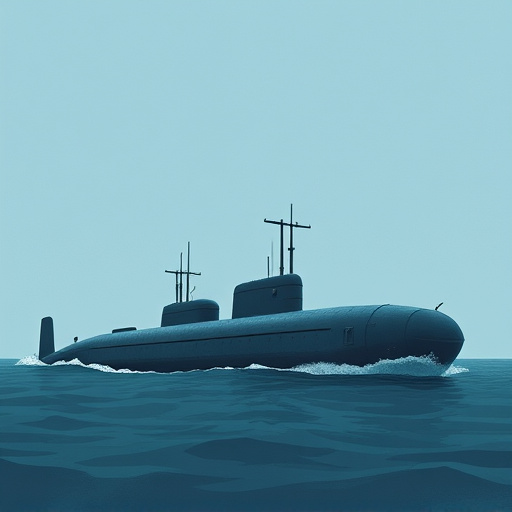“The submarine has evolved from a mere underwater vessel to a powerful tool for deep-sea exploration, pushing the boundaries of human knowledge. In this article, we delve into the top innovations transforming the future of submarine technology. From advanced propulsion systems enabling deeper dives, to enhanced sensory capabilities and sustainable designs, these breakthroughs are revolutionizing our understanding of the ocean’s depths. Explore how robotic arms and Remotely Operated Vehicles (ROVs) extend human reach, ensuring safe and eco-friendly exploration.”
The Evolution of Submarine Technology: A Historical Perspective
The evolution of submarine technology has been a remarkable journey, dating back to the late 19th century. Early submarines were little more than experimental vessels, powered by hand or steam, and designed primarily for short-distance exploration. However, these initial endeavors laid the groundwork for future advancements. As engineering prowess grew, so did the capabilities of submarines; they became faster, deeper diving, and more maneuverable.
The advent of electric propulsion in the 20th century marked a significant turning point, enabling submarines to operate with greater efficiency and stealth. This innovation opened up new possibilities for deep-sea exploration, allowing researchers to venture further than ever before. Today, cutting-edge submarine designs incorporate advanced materials, sophisticated navigation systems, and state-of-the-art communication technologies, pushing the boundaries of what we know about the ocean’s depths.
Advanced Propulsion Systems: Powering Deeper Dives
Submarine innovations in advanced propulsion systems are revolutionizing deep-sea exploration, enabling these vessels to reach unprecedented depths. Modern submarines now employ sophisticated electric drive systems coupled with highly efficient batteries, allowing for quieter and more maneuverable operations compared to traditional diesel-electric designs. This breakthrough facilitates closer interactions with marine life and minimizes the impact on delicate underwater ecosystems.
These advanced propulsion technologies also incorporate magnetic compression and superconducting motors, further enhancing diving capabilities. Such innovations not only increase the depth and speed at which submarines can operate but also extend their operational range. As a result, scientists and researchers have newfound opportunities to study the mysterious depths of our oceans, uncovering valuable insights into marine biology, geology, and climate change.
Enhanced Sensory Capabilities: Seeing and Hearing Beneath the Surface
Modern submarines are equipped with advanced sensory capabilities that allow them to navigate and explore the deep sea effectively. These include sophisticated sonar systems capable of detecting objects and mapping underwater landscapes, providing critical information for safe navigation and exploration. Additionally, new technologies like acoustic cameras enable visual observation beneath the surface, revealing previously unseen marine life and geological formations.
The integration of advanced sensors enhances a submarine’s ability to gather data accurately and efficiently. This includes improved hearing capabilities that detect even the faintest sounds, enabling communication with other submarines or surface vessels. These innovations push the boundaries of what we can achieve in deep-sea exploration, opening up new possibilities for scientific research, resource discovery, and underwater mapping.
Robotic Arms and Remotely Operated Vehicles (ROVs): Extending Human Reach
Robotic Arms and Remotely Operated Vehicles (ROVs) are transforming submarine exploration by extending human reach into the deepest and most inaccessible parts of the ocean. These advanced technologies mimic human dexterity, allowing them to perform complex tasks like manipulating objects, taking samples, and even repairing equipment, all while operating at extreme depths where humans cannot safely venture.
With their enhanced capabilities, ROVs enable scientists and researchers to gather data, collect specimens, and conduct experiments in environments previously unattainable. This not only expands our understanding of the deep sea but also paves the way for innovative applications in fields like marine biology, geology, and even mineral resource extraction. The future of submarine exploration promises even greater integration of these robotic systems, pushing the boundaries of what we can discover and achieve beneath the waves.
Sustainable and Safe Submersibles: Addressing Environmental Concerns
As we explore the vast and mysterious depths of the ocean, it’s crucial to do so responsibly. Traditional submarines often face environmental challenges, from leaving significant carbon footprints to potentially disturbing delicate marine ecosystems. Sustainable and safe submersibles are emerging as game-changers in deep-sea exploration, focusing on minimal ecological impact. These innovative craft employ advanced propulsion systems powered by renewable energy sources, reducing their carbon emissions and allowing for longer, more extensive missions without causing harm to the ocean’s biodiversity.
Additionally, these new submarines incorporate sophisticated navigation and communication technologies, enabling researchers to navigate treacherous underwater terrains with precision while maintaining real-time contact on the surface. By addressing environmental concerns, these sustainable submersibles not only preserve the ocean’s health but also open doors to unprecedented scientific discoveries, expanding our understanding of the deep sea in a responsible manner.
